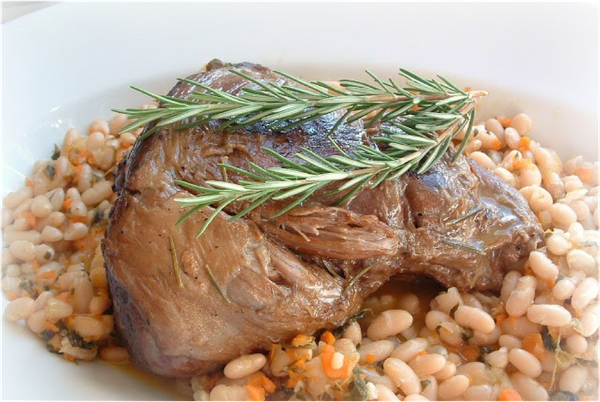Recipe: Leg of Lamb Braised in White Wine and Fresh Herbs
Our chef/poet really wanted to write about spring, so she offers a dish synonymous with the season.

Our chef/poet really wanted to write about spring, so she offers a dish synonymous with the season.

I was going to write about Easter and Passover, but when I found myself struggling to find something fresh to say on the subject I abandoned the premise. What I really want to write about after this long winter is spring. The advent of spring is so promising, especially in this part of the country. To witness shoots of flowers emerging from the formerly frozen and barren earth is nothing less than miraculous. To see leaves unfurl from skeletal branches on trees that appear devoid of life reminds me of the great mystery and regenerative power of Mother Nature. So spring has sprung (in theory) and in order to welcome the season and all its glory I decided to throw a small dinner party that featured a dish synonymous with the season, which of course, is leg of lamb.
I adore the gamey, tender succulence of lamb and was fortunate to be introduced to it at a very young age, when we lived in Beiru. We ate lamb prepared in a variety of ways: grilled on a vertical spit, carved, stuffed into a pita and served as schawarma; marinated in red wine vinegar, olive oil, garlic, and rosemary, then skewered, grilled, and served as a kebab; ground and mixed with spices and baked in a casserole layered with labneh, scored in diamonds, and served as kibbeh. As my travels expanded, so did my palate, and soon I was treated to the creamy richness of moussaka as well as the delectable medallions teased from the nearly aristocratic rack of lamb.
Lamb is not just a favorite of the Middle East but also a staple of many of the diets endemic to the European countries that form a necklace along the Mediterranean Sea’s coastline. And within this part of the world, I believe the French give their Asian Continent counterparts a run for their money when it comes to preparing lamb. So for my spring fête I chose a Provençal dish over a familiar Lebanese dinner and made a four-hour braised leg of lamb served over slow-cooked cannelinis. The dish should be served family style as the presentation is fantastic. The lamb is so tender it can be pulled apart with serving spoons – no need for carving.
Leg of Lamb Braised in White Wine and Fresh Herbs
Serves 6
1 (6- to 7-pound) leg of lamb, with or without the bone
Olive oil
1 Tbs. kosher salt
2 tsp. freshly ground black pepper
1 (750-ml) bottle dry white wine
2 cups chicken broth
2 heads of garlic, broken apart but not peeled
15 large sprigs fresh rosemary
15 large sprigs fresh thyme
6 bay leaves
Preheat the oven to 300°F.
Rub the lamb all over with olive oil and season all over with salt and pepper. Heat a very large Dutch oven over medium-high heat until it is hot. Add the lamb and sear on all sides for about 12 minutes, until it’s browned all over. Transfer the lamb to a plate.
Add the wine and broth to the pan and cook for a minute or two, scraping up all the brown bits in the bottom. Add the garlic, rosemary, thyme, and bay and put the lamb on top. Place the lid on the pot and bake for 4 hours, basting occasionally. (If you don’t have a lid, you can cover it tightly with two layers of aluminum foil.)
After 4 hours, the lamb should be very tender and falling off the bone. Transfer to a plate, cover tightly with foil, and allow to rest. Strain the sauce into a saucepan and press the garlic cloves with the back of a spoon until all the sweet flesh is added to the sauce. Bring to a boil, and then lower the heat and simmer for 10 to 15 minutes to thicken and reduce. Place the lamb on a serving platter, remove the cooking twine if you prepared a boneless leg, then pour ¾ cup of the sauce on top and the rest of it into a serving vessel. Surround the lamb with the beans (recipe follows) and serve with two large serving spoons. It should be so tender that it easily pulls apart.
Herbed Cannelinis
Serves 6
14 oz. dried Great Northern beans
1 quart homemade chicken stock or canned broth; more if necessary.
1 Tbs. kosher salt
1/4 cup good olive oil
2 cups chopped yellow onions (2 onions)
1 cup medium-diced carrots (2 carrots)
1 cup medium-diced celery (2 stalks)
1/4 cup chopped fresh parsley, plus more for garnish
1 Tbs. minced garlic (3 cloves)
2 Tbs. minced fresh rosemary
2 Tbs. minced fresh thyme
1/3 cup freshly grated Parmesan cheese
Put the beans in a bowl and cover with water. Soak in the refrigerator overnight.
Drain the beans, put in a large saucepan with the chicken stock, and bring to a boil. Lower the heat and simmer for 30 to 40 minutes, until tender but not mushy. Add the salt for the last 10 minutes of cooking. Drain, reserving the chicken stock.
In a large sauté pan, heat the olive oil, then add the onions, carrots, and celery and cook over low heat for 10 to 15 minutes, until tender. Add the parsley, garlic, rosemary, and thyme and cook for 3 more minutes. Add the beans and 2 cups of the stock. Cook for 15 minutes until the stock becomes reduced and thickens. If needed, add more of the reserved stock. Finish with the Parmesan cheese. Serve with a garnish of chopped parsley.